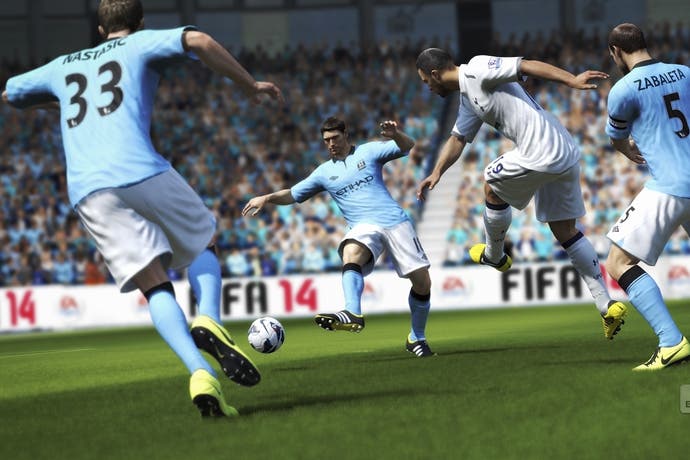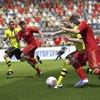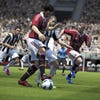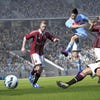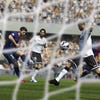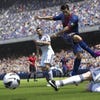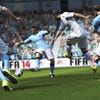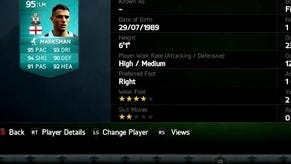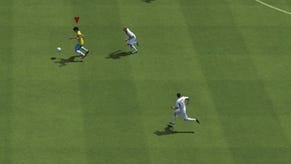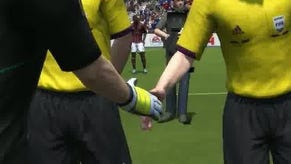FIFA 14: recreating the emotion of scoring great goals
Protect the ball.
Throughout FIFA's golden period, which has been in effect from FIFA 09 or 10, depending on your point of view, I've found a constant: once the new game comes out you quickly get used to it and then you wonder how you ever played the last version in the first place. Changes are almost always for the better (even the sometimes hilarious Player Impact Engine has proved itself a valuable addition). When the dust of the arguments around new features and gameplay tweaks settles, almost everyone is left happily playing the latest version. With FIFA, there's no going back.
Having listened to the people behind the series talk about how gameplay has improved for the next game, I suspect the exact same thing will happen when FIFA 14 releases this autumn. Some of the changes EA Vancouver is implementing are sure to spark heated debate, but when the dust settles, we'll all be playing the latest version, enjoying it, and thinking: there's no going back.
Producer Nick Channon's presentation is as much about FIFA 13 as it is about FIFA 14. He reveals new features in the same breath as he singles out parts of last year's game that weren't up to scratch. It's all about recreating the emotion of scoring great goals, he says - something FIFA has, on the whole, failed to do.
Central to this idea is the desire to force players to think more about attacking by improving defending. Defenders are now tighter to opposing players, so there's less space. Hopefully, it'll mean those annoying clearances from corners, which in FIFA 13 invariably landed at the feet of a striker who had the time and space to turn, sprint and launch a counter-attack, will occur less frequently. Generally, defenders will close down space and put pressure on the out ball more effectively than they did in previous versions.
If it works - FIFA 14 remains hands-off for now - it'll mean there's less "cheapness" and repetition to FIFA's attacking play. With FIFA 13, common types of attacks and goals have emerged. With FIFA 14, because your strikers will find it harder to find space, you, the player will find it harder to carve out chances. You'll be forced to think differently. You'll be forced to work the midfield. You'll be forced to try new things.
"We've tidied up the marking because it's loose and it's easy to get that through ball in," Channon explains to Eurogamer in a follow-up interview. "It's easier to run at the defender because by the time they've closed you down, you're at speed. At times you get the cheap goals, you get the goals where it's like, yeah, I've scored that one before. So, by tightening things up it naturally makes you have to think a little bit more to get the opportunity.
"Now, by having proper build-up play through midfield, you have to think a little bit more about football, and it's going to create more variety in the ways you can score."
By having proper build-up play through midfield, you have to think a little bit more about football, and it's going to create more variety in the ways you can score.
FIFA 14 producer Nick Channon
Defenders will also benefit from a tweaked Tactical Defending system. EA Vancouver says over 95 per cent of players use Tactical Defending, which sees defenders hover around their opponent without actually launching a tackle. Making a tackle from this position, the developers reckon, feels all-in, with no opportunity to recover from botched attempts because players had to go through the motion of completing the animation before they could recover. Now, there is a small window of opportunity to trigger a second chance tackle - a press of the B button on Xbox 360 - after the first attempt. It may work. It may not. But it's yet another defensive option in a series that favours attacking play.
As you'd expect, with improved, tighter defending comes more elaborate attacking and new run types. The "push off to spin in behind" run is included for the first time, and you'll notice strikers running alongside the line of defenders to stay onside as they wait for a through ball. Players can now back in to defenders - Didier Drogba style - before receiving the ball.
This last option is part of a new system that aims to make shielding the ball easier than it was in FIFA 13. Protecting the ball is a simple case of pressing and holding the L2/left trigger button. And here's where it gets interesting: you can use this with your controlled player running at any speed.
Channon likens "Protect the Ball", to give it its official name, to a driving game, where you press the right trigger to accelerate and the left trigger to brake. In this way you can better dictate the speed of play, which Channon admits has felt one-paced. Now, you can press the left trigger to slow down a winger, for example, who knows he's going to be caught by a fullback, then check inside or pass the ball, or perhaps try and dribble past him.
You can use Protect the Ball in all situations, and new animations have been added to fuel it. You can use Protect the Ball to swat away a defender who is trying to drag you back as you're bearing down on goal. You can use it to shove a defender as you're waiting for the ball to land. It's not a one-way street, either: defenders can use it too, creating what sounds like an interesting meta game as opposing players jockey for position.
Channon reckons Protect the Ball changes the feeling of FIFA significantly, and not just in terms of the pace of play or the battle for midfield. It should be noted that with L2/left trigger occupied skill moves are now governed exclusively by the right stick - you don't have to hold down the trigger any more.
Channon continues his presentation by highlighting another unsatisfactory aspect of FIFA 13. In that game, shooting triggered the same animation every time. Players would magically snap to the ball to shoot, sometimes gliding comically across the grass as the engine made the whole thing work.
Now, players will adjust their stride and angle their run before shooting, making for a much more realistic animation powering new shot types: the pure strike, the off balance shot, the rushed shot and the ball in feet shot. Players will do a little stutter step to sort out their feet before striking the ball, or wrap their run around the ball before shooting or crossing.
All this is governed by the simulation. The hope is that the different animations will act as "visual tells" for the player, so you understand better why certain shot types occur. Why did you miss? In past versions of the game you wouldn't know, because the animation for shots was the same every time. Now, perhaps it was because the striker was off balance - if it was you'll see that animation. Perhaps he was rushed, or couldn't get the ball out of his feet. Either way, Channon hopes players will change their thinking when it comes to shooting.
Now for what sounds to me like the most exciting gameplay change for FIFA 14: realistic ball physics. EA Vancouver has researched the way footballs drag, curve and spin, and found FIFA 13 had it all wrong. The drag coefficient, apparently, was too linear, which means there was linear deceleration - that is, the ball didn't move much at all. The flight of the ball was dull.
In real life, of course, the ball moves all over the place - think a Ronaldo freekick that dips and swerves before crashing into the net. FIFA 14 hopes to simulate this with a non-linear drag coefficient.
In gameplay terms, players can now strike the ball harder and put more spin on passes and shots. You can now perform curling lofted through balls - a surprising first for the series. When it comes to finishing, you might get a low-rising shot - Steven Gerrard's speciality, a turbulent shot that moves in the air, or perhaps a dipping shot - Gareth Bale's trademark. There are no input commands for these shots. They are emergent, governed by the simulation and the context of the shot itself. They're designed to make players "feel the emotion of scoring great goals", EA says.
"It's fundamentally just how you kick the ball," Channon tells us. "It's not a forced thing. Because the drag was wrong on the ball, we were getting a very flat trajectory. The ball wasn't spinning very much. As soon as you start adding spin you get that. It's a natural behaviour."
We've heard the likes of "real ball physics" before from game makers in the run up to the release of new entries in annual sports series, of course, and I'm mildly concerned that the new ball physics could result in hilarity in much the same way the Player Impact Engine did when that was first introduced, but its addition is coming from the right place: the desire to make goals more interesting and realistic.
Bar these gameplay changes, Channon is keeping his cards close to his chest. He mentions there will be new skill games inspired by those "chase the ball" warm up sessions all the clubs do, and a new and improved user interface for Career Mode, which should benefit from a new global scouting network (he won't mention how the menus have been improved across the game as a whole).
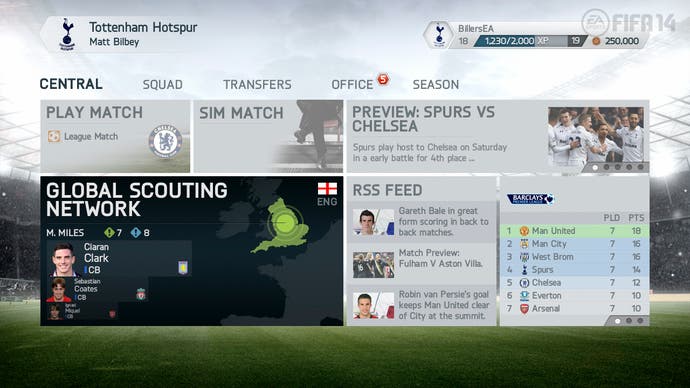
For me, EA is talking the talk but it has yet to walk the walk. We still don't know how the game looks or feels to play, or anything about the inevitable PlayStation 4 and next Xbox versions and how they will differ from the current-generation versions - if at all. We don't know anything about Ultimate Team or online play, either - for many the whole point. But I'm glad EA's reveal of FIFA 14 has focused on gameplay changes because, after all, their success or failure is what will determine the game's popularity months after release.
What we do know suggests to me that EA Vancouver is on the right track with FIFA 14. Protect the Ball should add nuance to the flow of play, which, if your matches are anything like ours, can often feel like basketball-style end to end slug-fests. And the more realistic ball physics suggest the game will still surprise even after months of game time. I suspect, a couple of weeks after the game launches, there will, once again, be no going back.
